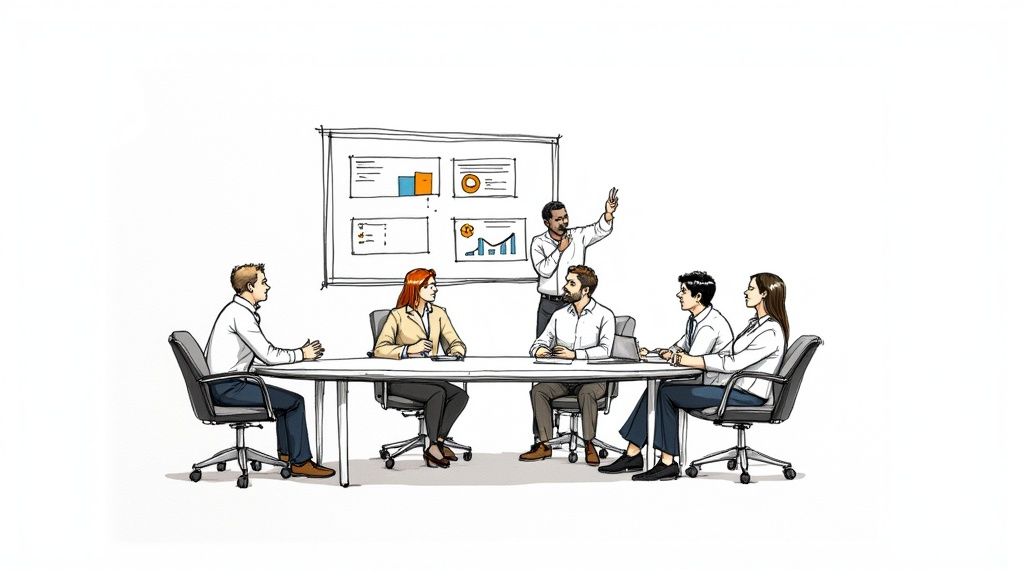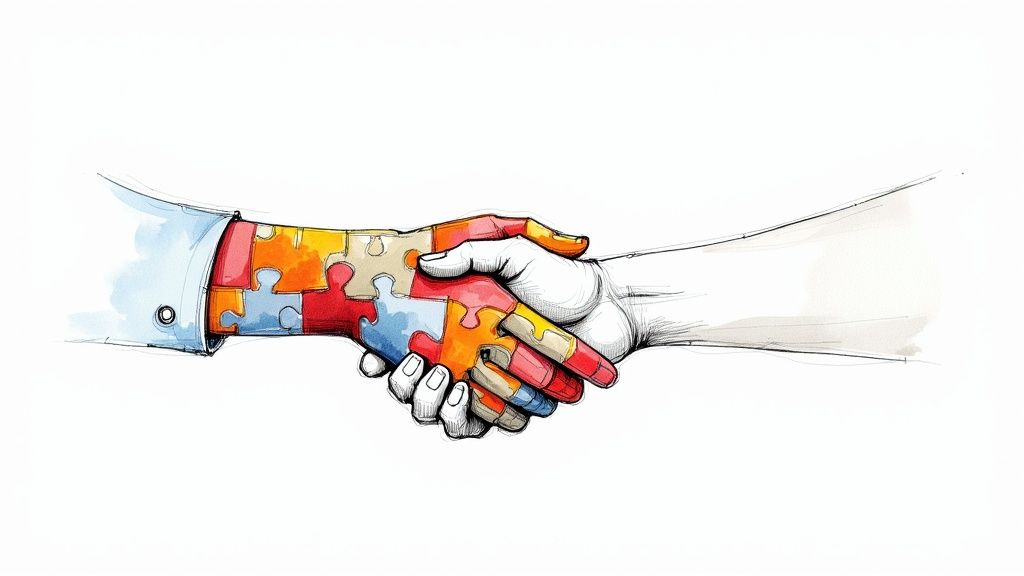August 1, 2025

Lots of organizations treat nonprofit board member training as just another formality—something to check off a list. But that view misses a critical truth. When a board isn't properly equipped, it can unintentionally create huge risks, from funding gaps and mission drift to serious damage to your reputation. Thinking of training as a strategic investment is key to building a resilient organization.
It's time to stop seeing board training as a simple checkbox item. When passionate, dedicated people join your board, they bring incredible experience. That's a given. But passion alone doesn't translate into effective governance. An untrained board isn't a sign of uncommitted members; it's a symptom of a weak support system.
The consequences of this knowledge gap can be pretty severe. Imagine a board member who, with the best intentions, approves a budget that puts the organization on shaky financial ground simply because they've never been trained to read nonprofit financial statements. Or think about a board that completely misses a major grant opportunity because no one ever explained their collective role in fundraising and high-level strategy.
These aren't just hypotheticals. They're common, real-world problems that can stop a nonprofit's mission dead in its tracks. The biggest risks of skipping proper board member training for a nonprofit boil down to a few key areas:
"What you need for a successful board are people who understand the fiduciary obligation, understand the legal obligations... and can help coach and guide... the nonprofit executive director... And that requires the board member to have a certain understanding of leadership." – Dottie Schindlinger, Executive Director of Diligent Institute
A structured orientation and a commitment to ongoing education really work. The proof is in the data. Research consistently shows that board members who go through formal training report a major jump in both their knowledge and their confidence. Before training, many admit they felt uncertain about their governance duties. Afterward, they feel genuinely prepared to dive into strategic planning and help manage resources effectively. You can dig into the full findings on how training boosts board member confidence and preparedness.
Ultimately, investing in your board members isn't a cost—it’s a foundational strategy. It’s how you build a resilient, effective, and high-impact organization. It turns well-meaning volunteers into a powerful, unified team ready to steer your nonprofit toward a successful and sustainable future.
A great board training program is built on a solid curriculum. While the specifics will always change from one nonprofit to another, there are a few core topics that are simply non-negotiable if you want your board members to govern with confidence. This isn't about having them memorize the bylaws; it’s about giving them practical, real-world skills.
The idea is to get beyond theory and into actionable knowledge. A well-thought-out curriculum ensures everyone, from a seasoned CEO to someone brand new to board service, is on the same page about their duties and the organization's strategic goals from day one.
The absolute heart of any training program has to be the three legal fiduciary duties: Care, Loyalty, and Obedience. Just listing them on a slide won't cut it. You have to make them real with scenarios they can sink their teeth into.
This image really helps visualize how these crucial roles fit together.

As you can see, oversight, advocacy, and fiduciary duties all overlap. They're all central to what makes a board effective.
Let's be honest: many board members don't come from a finance background. That can make budget reviews feel pretty intimidating. Your training needs to demystify financial oversight. Don't just throw a spreadsheet at them; teach them how to read it.
Take the time to walk them through your key financial documents—the Statement of Activities, the Statement of Financial Position—and explain what the numbers actually mean for the organization's health.
A board that can't read its own financial story cannot effectively plot its future. Financial literacy isn't just a treasurer's job; it's a collective board responsibility that protects the organization and its mission.
Board members are the ultimate guardians of the mission. Your training has to connect the dots between their work in the boardroom and the organization's strategic plan. Make it clear how their decisions drive real-world impact and help steer the ship toward its long-term vision.
Fundraising is also a team sport, and effective board member training for a nonprofit should prepare them for it. This means giving them the tools for ambassadorship, providing strong financial oversight, and even participating in direct fundraising, depending on their role and comfort level. As you foster this kind of engagement, you might find some useful tips in our guide on how to start a community to rally people around your cause.
The best programs I've seen always include a mix of new member onboarding, core governance training, and continuous education on evolving topics. By creating engaging, practical content, you give both your new and veteran members the skills they need to truly excel.
Let's be honest: even the best-designed training content will flop if the delivery is off. The "how" you teach your board members is just as critical as the "what" you're teaching them. Choosing the right format is the difference between genuine learning and just another item to check off the to-do list.
The key is to move past a one-size-fits-all mindset. You need to make a strategic choice based on who your board members are, where they live, and what they need right now. A brand-new board might thrive on the energy of an in-person workshop, while a group of seasoned veterans might prefer short, focused webinars that respect their packed schedules.
Think through a couple of common situations. Say your board members are scattered all over the country. Asking them to fly in for multiple training sessions a year is not just a huge expense; it's a real barrier that can tank participation.
In that scenario, a blended or fully virtual approach is a no-brainer. You could use self-paced online modules for the foundational stuff—like fiduciary duties—and then bring everyone together for live quarterly webinars to tackle big-picture strategy and Q&A. This respects their time while still building that crucial sense of connection.
Now, flip that around. Imagine you’re working with a new board for a startup nonprofit. These folks need to build trust and a shared sense of purpose just as much as they need to understand the financials.
For a new board, an intensive, in-person retreat can be a game-changer. It creates the focused time and space they need not just to absorb critical information, but also to forge the personal relationships that are the foundation of great teamwork and governance.
There’s no single "best" method here. What works depends entirely on your context. Your job is to weigh the pros and cons of each to build a program that clicks with your specific group of leaders.
At the end of the day, picking your training method comes down to being realistic and empathetic. When you consider the practical realities your board members are dealing with, you can design a program they don't just attend, but actually find valuable. This thoughtful approach is what turns your training investment into a more informed, engaged, and effective board.
Let's be honest: effective board member training for a nonprofit isn't something you can just check off a to-do list after a single orientation session. That initial onboarding is absolutely critical, but the real magic happens when you build a culture where learning is an ongoing part of board service. This approach is what transforms a good board into a great one, creating a dynamic space where members are always honing their skills and deepening their connection to your mission.
The idea is to weave professional development right into the fabric of what it means to be a board member. And here's the good news—it doesn't have to be some massive, budget-draining program. It’s about creating consistent, bite-sized opportunities for growth that keep your leaders engaged, sharp, and perfectly aligned with your goals.

The most practical way to make this happen is to stop treating training like a separate event and start integrating it into your regular board routine. When learning becomes a normal part of the process, it feels less like homework and more like a valuable part of the job.
Try dedicating just 15 minutes of every board meeting to a "mission moment" or a quick "governance spotlight." One month, you could pull up a key goal from your strategic plan and discuss progress. The next, you might spark a conversation around a new fundraising trend you’ve noticed. These small, consistent touchpoints are surprisingly powerful for keeping important topics top of mind.
Another strategy I've seen work wonders is a simple mentorship program. Pairing a seasoned board member with a newcomer offers incredible one-on-one support. The new person gets a trusted guide to navigate board dynamics, while the veteran gets a chance to reflect on their own leadership and pass down that priceless institutional knowledge. It's a win-win that builds both individual confidence and overall board cohesion.
You don’t need an elaborate, expensive system to support ongoing education. A simple, well-organized digital space can be a game-changer. Using a platform like GroupOS, you can easily set up a central hub where board members can find everything they need, whenever they need it.
A living library of resources empowers board members to take ownership of their learning. When they can easily find relevant articles, case studies, or past financial reports, they are better equipped to prepare for meetings and contribute thoughtfully.
Think of your resource library as a dynamic tool, not a dusty archive. Keep it fresh and valuable by regularly adding content like:
Cultivating this environment encourages board members to ask better questions and share insights more freely. This commitment to continuous learning is the bedrock of strong governance and creates a positive ripple effect across your entire organization. For more ideas on keeping your key people invested, check out these powerful community engagement strategies to build lasting connections.
So, you've invested time and resources into training your nonprofit's board members. How can you be sure it's actually working? Simply tracking who showed up won’t cut it. To truly understand the return on that investment, you need to look past the surface-level metrics and dig into the real-world changes in behavior and strategy.
This is about shifting from vanity metrics to meaningful evidence. The idea is to gather both stories and numbers that together paint a clear picture of progress. When you can draw a straight line from your training sessions to better governance, you've built an undeniable case for continuing to invest in your board's development.
Pre- and post-training surveys are a great place to start. They're essential for capturing that immediate snapshot of how knowledge and confidence have shifted. Asking members to rate their understanding of fiduciary duties before a session and then again afterward gives you a clean, quantifiable data point.
But the real test isn't what happens in the training room; it's what happens in the boardroom weeks and months later. The goal isn't just for board members to feel more knowledgeable—it's for them to act more effectively and strategically. This requires looking at how their behaviors evolve over the long haul.
True impact is measured in the boardroom, not just in the feedback form. Look for evidence of more strategic questions, deeper financial scrutiny, and a greater willingness to engage in complex discussions. This is where training proves its worth.
Often, the proof you're looking for is hiding in plain sight, embedded in your organization's regular activities. If you know where to look, you can uncover some powerful indicators of success.
Ultimately, measuring impact is all about telling a compelling story with data. You need to connect the dots between the specific training you provided and the positive outcomes your nonprofit is seeing. It’s about demonstrating how an informed, engaged board directly contributes to a stronger, more resilient organization.
This data also feeds directly into retention. Board members who feel themselves growing professionally and see their contributions making a tangible difference are far more likely to stay committed. For a deeper dive into keeping your best people on board, check out these proven membership retention strategies.
By weaving together these qualitative stories and hard numbers, you build a powerful narrative. You prove that your board member training program isn't just another line item on the budget—it's a high-return investment in the future of your mission.

When you're building out a board member training nonprofit program, the big-picture strategy is one thing, but the practical, on-the-ground questions are what often trip people up. How much should this cost? Are we legally required to do this? And what on earth do we do when our members have wildly different levels of experience?
Let's tackle some of the most common questions I hear from nonprofit leaders.
This is the classic "how long is a piece of string?" question. There's no single right answer, but one thing is certain: the answer can't be zero. Your budget is going to be driven entirely by the methods you choose.
If you're lean, you could get by with self-paced learning using existing materials, which costs next to nothing. On the other end of the spectrum, bringing in a professional facilitator or hosting an off-site retreat represents a much more significant financial commitment.
My advice? Start small and prove the concept. Earmark a modest amount for a few high-impact resources, like a subscription to a respected governance publication or access to a webinar series. Once you can show how that small investment improved board engagement or effectiveness, you’ll have a much stronger case to make for a larger training budget next year.
This is a critical question, and the answer is a firm "it depends." For most nonprofits in the US, UK, and Canada, there isn't a sweeping law that says "you must train your board." However, all board members are required to fulfill their fiduciary duties, and that comes with an implied responsibility to be competent enough to do so. Training is how you ensure that competence.
Where it gets less gray is in specific industries or locations. You'll often find stricter, explicit rules in certain sectors.
Your best bet is to always check the regulations for your specific sector and location. When in doubt, a conversation with your legal counsel is the best way to navigate these requirements.
Board service is a powerful leadership incubator. It’s not just about compliance; it's about development. Investing in your members helps them grow, which in turn strengthens your entire organization and its mission.
This is a massive—and often overlooked—benefit. One study revealed that 80% of respondents felt they became better leaders as a direct result of their board service. They pointed to new skills in governance (65%), networking (58%), and strategic planning (52%). This data makes it clear that nonprofits are developing skilled leaders who benefit the entire community. You can dig deeper into the research on how nonprofit board experience develops leaders.
Ah, the classic dilemma. You’ve got a seasoned CEO sitting next to a passionate community advocate who has never looked at a balance sheet. Trying to train them in the same room with the same material can be a real challenge.
The solution is a multi-layered approach that meets people where they are.
Your orientation must cover the non-negotiable basics for everyone—mission, legal duties, and core programs. Beyond that, think in tiers. You could create an advanced "deep dive" on financial oversight for your finance committee, while offering a foundational "Finance 101" session for anyone who wants it.
A mentorship program is another fantastic tool. Pairing a veteran board member with a newcomer provides that personalized, one-on-one guidance that a group session can never replicate.
Ready to build a smarter, more connected board? GroupOS provides the all-in-one platform you need to create a central resource hub, manage training registrations, and foster a culture of continuous learning. Discover how GroupOS can transform your board engagement today.


